
History Book of BEST
.pdf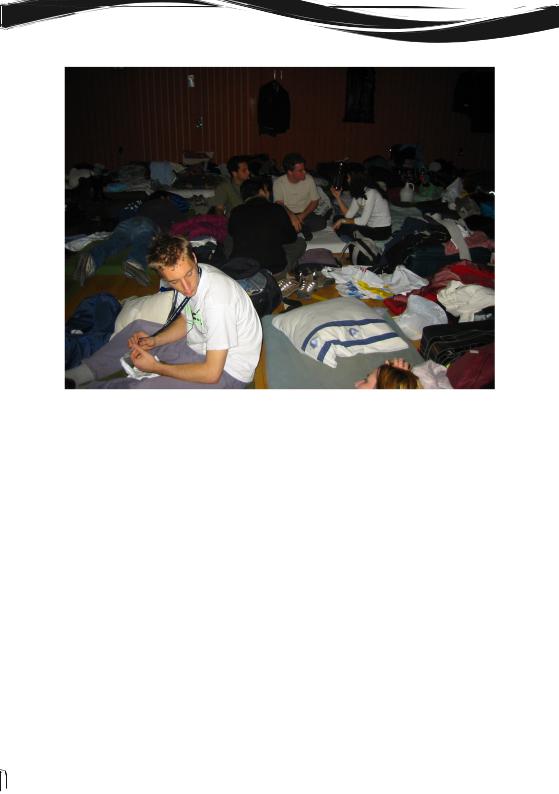
201
GA2004 sleeping area
The presence of at least 50% + 1 of the members is necessary to validate the decisions. The decisions are made by absolute majority of members present unless otherwise specified. The president with the assistance of the board guides the assembly and presents the biannual report. The treasurer presents the financial report. Both reports have to be approved by the GA. The GA elects the new board according to the IR.”
Since the proposed statutes were approved by the people attending the Working Reunion, they were automatically turned into the General Assembly of BEST, making it the first official BEST event in the history. The vision and the powers of that very first General Assembly of
BEST still remains the same today and it’s proud to be the longest living body in BEST.
First President’s Meetings
After 7 continuous years of successful General Assemblies in BEST, a new idea was dropped on the table: since the organisation was already getting well established, and since the board would have from now on a 1 year long mandate, why not organising only one General Assembly during the year, and replace the second General Assembly with a smaller one, where there would only be one delegate from each LBG?
This idea came to life for the first time in October of 1995 in Trondheim. The new meeting

Chapter 6:
BEST Internal Events
was called ‘Presidents’ Meeting’ and only one delegate from each LBG was invited. Having this event made the family of the decision making bodies of BEST to double, since decisions could be taken as well during the Presidents’ meetings. It was decided that more important decisions would be voted again only during a General Assembly, such as changes in statutes, elections of the board etc.
Development of General Meetings
Even though the core of the General Meetings remained the same after 20 years, there are some things that changed the way General Meetings happened. Here is a short time-line of important changes concerning the General Meetings:
•1989 First GA of BEST
•1989 in GA Vienna - Working done in subgroups
•1991 in GA Paris: Home-works are given to each LBG. They had to work on the topic they received and present the outcomes in the next GA
•1991 in GA Lisbon: Speaker’s Corner appears for the first time
•1992 in GA Helsinki-Tallinn: The board presents their half annual report
•1994 in GA Timisoara: First attempt to tell the history of BEST
•1995 in PM Trondheim: First Presidents’ Meeting
•1997 in PM Warsaw: Committee presentations slowly appear
•1998 in GA Romania: The focus of the meeting switched from working to informing, that’s why Discussion Groups instead of Working Groups were scheduled
•1998 in PM in Torino: First time LBG Reports appear.
•1999 in PM in Chania: Training for the delegates is delivered
•2000 in PM in Budapest: LBG Therapy is applied: Tips and tricks are given to LBGs that need them. Also evaluation of the event appears for the first time
•2001 in GA in Ljubljana: A Committee Rally is organised in order to help people understand what the work of the committees is.
•2003 in GA Slovakia: LBGs have the chance to show why are they proud during the LBG Show session
•2004 in GA Oresund: First GM that is covered by live video streaming.
•2006 in GA in Zagreb Gala awards are given to LBGs
•2007 in PM Valladolid: The wake up hour is moved one hour later. This proved to be very efficient for the whole meeting
•2008 in PM Bucharest: Alumni are invited to attend the plenary sessions
•2009 in GA Budapest: Parallel plenary appeared for the first time
202

203
Group Picture PM Chania, 1999
New development in decision making in BEST
After 20 years, BEST is proud to have organised 27 General Assemblies and 14 Presidents’ Meetings. However, things are moving and new technology gave us the right tools to change the way of making decisions in BEST. In GA2009 in Budapest, after 3 years of working, a new decision making body is made official in BEST: Virtual International Plenary! Read more about it in another paragraph.
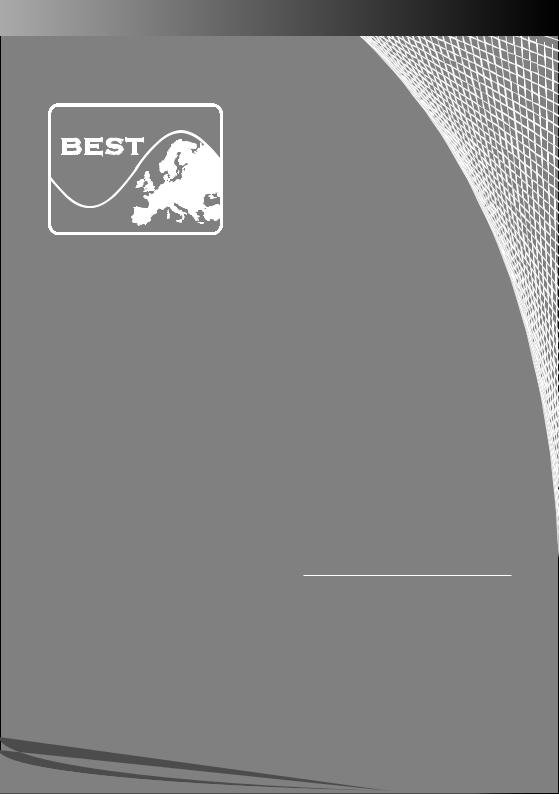
History Book of Board of European Students of Technology |
1989-2009 |
Chapter 7
BEST Projects
•BEST on paper
•Visual Identity
•Recognition
•University project
•VIP

205
BEST Projects
BEST on Paper
During 20 years of existence, BEST developed many materials of promotion, information designated for BEST members and students in general. Before the online promotion, the members all around Europe turned to promotion through flyers, brochures and catalogues.
Even from the International Week in Grenoble, 1988, the delegates wanted to make a brochure with the purpose of informing the students of Europe of the educational offer each university member of he EAU had. Even if the plan was simple there were some problems like bad communication between the groups and funding.
After 4 years, in 1992, the delegates of the VII-th General Assembly of BEST voted to create the BEST Magazine. This magazine was different from the initial idea and became a promotional tool for BEST. The magazine was supposed to be done by LBG Lund until the next General Assembly as LBG homework.
The BEST Magazine was the annual publication of BEST. The publication was addressed to
BEST members but in the first place it was used as an introduction for those who never met
BEST before or had only a very vague picture on the association.
The content in general was meant to be informative for those who didn’t know too much about BEST, but it had to be still interesting for the ones who were working in the organisation. Therefore the main focus was on the previous year’s activities (state of the art of the major projects, reports from the most important events etc.) and some general information on the association. The magazine was used for promotion towards the companies that could be potential sponsors of BEST.
Besides this, each number contained presentations of one or two LBGs and their activity, background stories about topics, interesting for European students and guest writings. The aim was to get the president of the European Commission, the president of Poland back than, professors or managers to write an article in the publication.
Below are some words from the GA Bratislava report by LBG Lund:
“The goal of the magazine
Our aim is to print 10 000 copies which will be distributed for free to all LBGs. The magazine will be so full of ideas and information that students reading this will become enthusiastic and will seize the possibilities to work and study abroad. The students will become aware of the happenings in BEST-Universities. The events at our Universities and in our towns will become more than just incomprehensible titles. This magazine can market BEST among
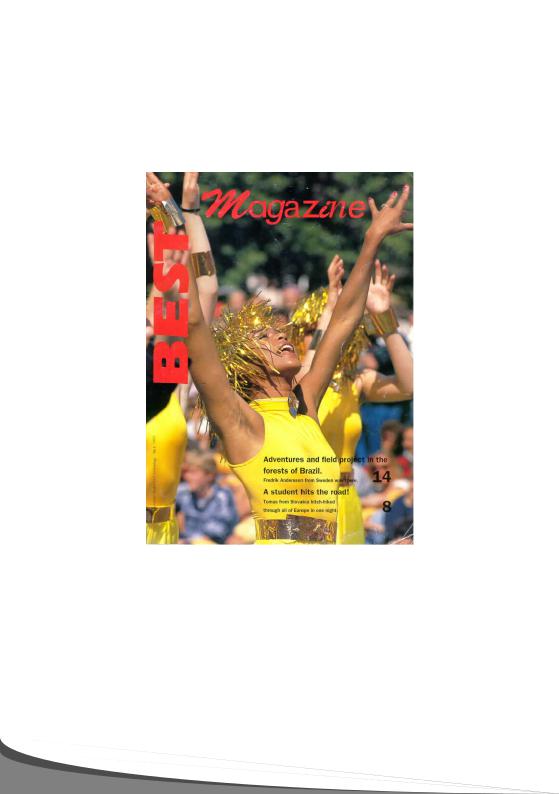
Chapter 7:
BEST Projects
students, administrative staff at the Universities and contact persons in the industrial sector.”
In 1993 the first issue of BEST Magazine appeared.
Realisingthatthispublicationwasasuccess,theBoarddecidedtomakeitayearlypublication. However, finding sponsors and good articles were some of the challenges the members had, but each year, BEST magazine was published and spoke about this student organisation.
cover of BEST Magazine, first issue
Through the years, the structure of it changed, many articles were inserted that talked about the Summer Courses, Cultural Exchanges between the LBGs, the educational involvement of BEST, different events that presented interest for the organisation, partners of BEST and different opportunities for students like internships or scholarships.
At the Workshop in Porto in 1997 the topic of the BEST magazine was discussed and were identified several problems like communication and sending of articles with delay, the lack of money to print the magazine, structure and distribution.
“It seemed obvious that it is necessary to build up an organisational structure for the making
206

207
of BM. Otherwise it’s not possible to secure that the magazine consists the “right articles”, an acceptable layout and a keeping of the deadline”.(WS Porto 1997 report)
Other solutions to the problems were to have a representative of BEST magazine in each LBG and to create a chief editing board consisting of 3 members.
For the 4th magazine, the goal of the magazine changed into a more annual-report of the activity at an international level. From WS Lulea report, 1998:
“The aim of the magazine is to present BEST in an interesting way to students (BEST and non-BEST members), companies, universities, professors etc. It should also be an annual report of all BEST activities and projects in the previous year.”
Also there was a shift in editorial style; issues from 1 to 3 had been done independently by individual LBGs (Lund, ENSAM, and Turin) while from issue 4 onwards the responsibility for content was more taken by the board.
For the issues from 5 to 7, the target group of the magazine was primarily on external audience (students, universities, companies) and no longer on BEST members.
All of the issues were printed except issue number 7. Issue 6 and 7 were published online. Issue 7 was originally also planned to be printed, but was in the end only published online due to lack of interested advertisers.
For these last issues it was easier to collect articles because BEST had a growing activity at international and local level. All of the BEST magazines were financed purely by sales of advertisement space to companies/universities, since there was no money on common account to be able to finance it. This was also a bottle neck in the procedure, since problems in obtaining advertisements could lead to delays or cancelling of the publication.
In GA 2002 there was a discussion group that decided to split the BEST magazine concept into two different publications, with tighter focus groups (instead of trying to cover companies, universities and students):
•Official Annual Report, aimed at companies
•BEST magazine, aimed at students
Also the responsibility for these two was moved over to markeTeam from the board. However, no actual work was started to put together a new issue of BEST magazine (though there was work on the Annual Report), and eventually by summer 2003 the whole concept of BEST magazine was abandoned by decision to produce instead other types of promotion materials aimed at students.
For the issue no. 6, the editor, Risto Koivunen from LBG Helsinki said:
“With another advertiser that bought a half-page advertisement, there was a misunderstanding

Chapter 7:
BEST Projects
about the dimensions between us and their designer. So while we had reserved a 210 x 150 mm space in the layout for this advertisement, we instead got a one with 150 x 210 mm dimensions. Apparently the standards of expressing width x height were different in advertisement trade than the ones found amongst engineers. In the end we decided to just give them a full page advertisement for the price of half a page.
The delivery of the magazines to LBGs for this issue was done in PM 2000 (organised by LBG Budapest), so the layout and printing responsible (who was from Zagreb) ended up travelling to the PM with a rented van, loaded full of magazines. And the presidents had to figure out a way how to fit their 100 copies to their luggage on the way home.”
For the Annual Report of 2001-2002 the structure was more corporate oriented and all of the inside information was not published anymore. The topics were the presentation of BEST’s activity for that year, the projects and relevant events and all of the educational, complementary work and career support BEST has done that year.
For the next issue, more space has been given for advertising but without neglecting the topics that represented BEST. The AR grew in pages from 20 at its first issue to 28 at the second.
Year by year new approaches and improvements were brought to the AR. “Just some really few ideas for future designers to think of:
•To structure clear, “maybe by different colours”, services, internal management, etc.
•Instead of the headings like they were this year maybe some slogans, that are highlighting the quality idea” (Board Summer Meeting 2004 report on AR session)
Year by year a new BESTie is elected to plan and coordinate this project. After gathering the articles, the responsible inside markeTeam takes care of the design of the magazine.
For all of these issues we can thank the AR team that year by year worked in finishing the publication on time. However, there were a couple of years in which the AR was published and handed out to the LBGs and other parties with delays.
These are only a few of the materials that speak about the work and efforts of this students’ organisation.
Article written by Risto Koivunen and Mirela Andriescu
208
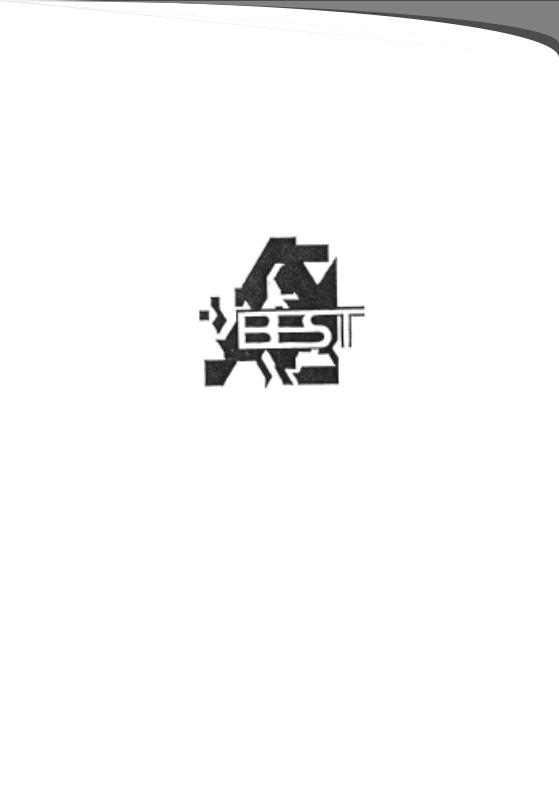
209
VISUAL IDENTITY of BEST
The first logo
The beginnings are never easy. The great organisation called BEST was born and it needed some visual element that would show our identity. From the international week in Grenoble in 1988, the participants wanted to define the aims, structure and identity of the newly created students’ organisation. Sketches were made defining a common visual identity and by the meeting in Eindhoven, the map of Europe below the BEST acronym was used on reports.
The logo on the Eindhoven report
At the meeting in Berlin 1989, there were 3 proposals for the logo of BEST.
“Three new designs have been made and it was voted whether to keep the old one, accept one of the new ones or design a totally new sign.” The new concepts were “the atomic model”, “the sinus wave” and “the circle”. Since none of the new designed logos were accepted, it was decided to combine the sinus wave with the old logo. The responsibles for the new logo were the members from Switzerland (Zurich). However, Zurich didn’t have much activity in the next future and didn’t succeed in their task.
The first official logo was the logo of LBG Trondheim produced before the BEST meeting in
Trondheim around 1990 by a senior architecture student Anette Dietrichson. It contained the map of Europe, sinusoid on an oscilloscope screen that represented the engineering students, and a Viking ship. All of the other LBGs were enthusiastic about the logo, but because Trondheim made a personalised logo for their university and town, the LBGs replaced the Viking ship and kelp all the other elements. The first time it was used on materials was on black cotton sweaters that all participants received at the BEST meeting in Oslo in 1990/1991.
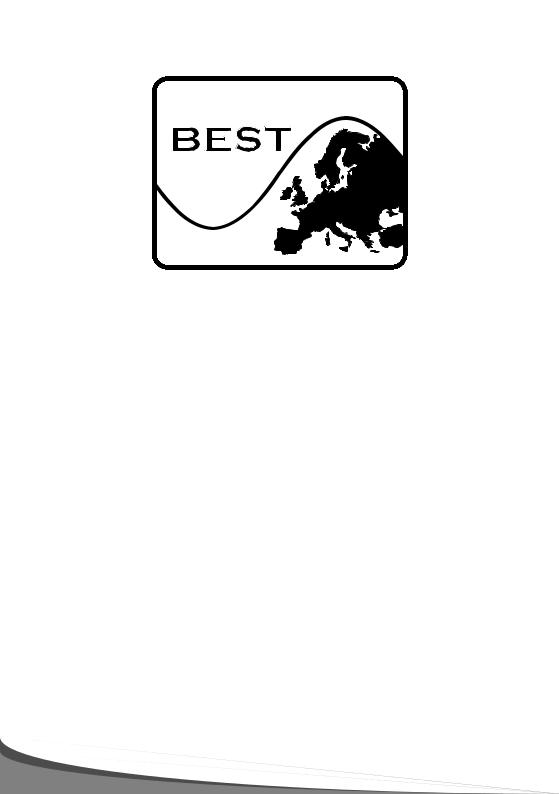
Chapter 7:
BEST Projects
Official logo of BEST from 1990 till 2007
At the same time, the delegates were keen on having a colour representative of BEST. It was voted that the official colour of BEST should be a dark green and the counter proposal to have it blue was rejected. Even if we had common elements, the logo was different from one LBG to another. One aspect was its dimensions. For example Warsaw and Tallinn had it really high and thin in comparison with the other groups.
The BEST members realised that there was still work to be done considering the Visual Identity. Meetings were made and lots of LBGs discussed how they can improve the Visual Identity of BEST and reach a Common Image. The path was rocky as the group members of the organisation were so diverse, but with the determination of some international involved members, it was possible in PM 2007 in Valladolid.
First attempts to change the logo
Starting from 1995-1996, every 4 or 5 years there were attempts to reach a Common Image of BEST. As rocky as the path was, it was interesting and exciting in the same time. After some time, the people interested in marketing realised that the logo was not really fitting us. It was complicated, what made it more difficult to print on promotion materials, like t-shirts for example, and it was not that obvious that there shape is supposed to be oscilloscope with sinusoid on it that should represent the engineers.
At GA 2000 in Sweden we faced one of the attempts to introduce a new logo. Yiannis Zevgolis, markeTeam coordinator at that time, made a proposal to change it....into a “worm”. That was the name that the proposed logo got, even though some people say it should be called “hanging tits”. The proposal was rejected.
“One strategy of putting common image into order and to get LBGs to follow guidelines was through new Logo, however we were only after achieving a way of organization displaying
210
